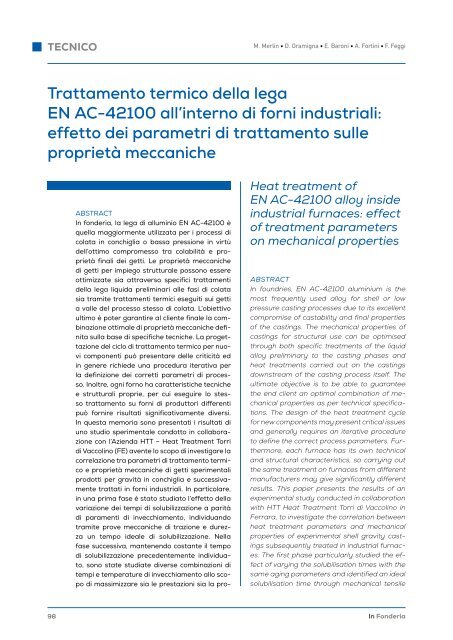In Fonderia 1 2024
Primo numero del 2024 di In Fonderia
Primo numero del 2024 di In Fonderia
Create successful ePaper yourself
Turn your PDF publications into a flip-book with our unique Google optimized e-Paper software.
TECNICO<br />
M. Merlin • D. Gramigna • E. Baroni • A. Fortini • F. Feggi<br />
Trattamento termico della lega<br />
EN AC-42100 all’interno di forni industriali:<br />
effetto dei parametri di trattamento sulle<br />
proprietà meccaniche<br />
ABSTRACT<br />
<strong>In</strong> fonderia, la lega di alluminio EN AC-42100 è<br />
quella maggiormente utilizzata per i processi di<br />
colata in conchiglia o bassa pressione in virtù<br />
dell’ottimo compromesso tra colabilità e proprietà<br />
finali dei getti. Le proprietà meccaniche<br />
di getti per impiego strutturale possono essere<br />
ottimizzate sia attraverso specifici trattamenti<br />
della lega liquida preliminari alle fasi di colata<br />
sia tramite trattamenti termici eseguiti sui getti<br />
a valle del processo stesso di colata. L’obiettivo<br />
ultimo è poter garantire al cliente finale la combinazione<br />
ottimale di proprietà meccaniche definita<br />
sulla base di specifiche tecniche. La progettazione<br />
del ciclo di trattamento termico per nuovi<br />
componenti può presentare delle criticità ed<br />
in genere richiede una procedura iterativa per<br />
la definizione dei corretti parametri di processo.<br />
<strong>In</strong>oltre, ogni forno ha caratteristiche tecniche<br />
e strutturali proprie, per cui eseguire lo stesso<br />
trattamento su forni di produttori differenti<br />
può fornire risultati significativamente diversi.<br />
<strong>In</strong> questa memoria sono presentati i risultati di<br />
uno studio sperimentale condotto in collaborazione<br />
con l’Azienda HTT – Heat Treatment Torri<br />
di Vaccolino (FE) avente lo scopo di investigare la<br />
correlazione tra parametri di trattamento termico<br />
e proprietà meccaniche di getti sperimentali<br />
prodotti per gravità in conchiglia e successivamente<br />
trattati in forni industriali. <strong>In</strong> particolare,<br />
in una prima fase è stato studiato l’effetto della<br />
variazione dei tempi di solubilizzazione a parità<br />
di paramenti di invecchiamento, individuando<br />
tramite prove meccaniche di trazione e durezza<br />
un tempo ideale di solubilizzazione. Nella<br />
fase successiva, mantenendo costante il tempo<br />
di solubilizzazione precedentemente individuato,<br />
sono state studiate diverse combinazioni di<br />
tempi e temperature di invecchiamento allo scopo<br />
di massimizzare sia le prestazioni sia la pro-<br />
Heat treatment of<br />
EN AC-42100 alloy inside<br />
industrial furnaces: effect<br />
of treatment parameters<br />
on mechanical properties<br />
ABSTRACT<br />
<strong>In</strong> foundries, EN AC-42100 aluminium is the<br />
most frequently used alloy for shell or low<br />
pressure casting processes due to its excellent<br />
compromise of castability and final properties<br />
of the castings. The mechanical properties of<br />
castings for structural use can be optimised<br />
through both specific treatments of the liquid<br />
alloy preliminary to the casting phases and<br />
heat treatments carried out on the castings<br />
downstream of the casting process itself. The<br />
ultimate objective is to be able to guarantee<br />
the end client an optimal combination of mechanical<br />
properties as per technical specifications.<br />
The design of the heat treatment cycle<br />
for new components may present critical issues<br />
and generally requires an iterative procedure<br />
to define the correct process parameters. Furthermore,<br />
each furnace has its own technical<br />
and structural characteristics, so carrying out<br />
the same treatment on furnaces from different<br />
manufacturers may give significantly different<br />
results. This paper presents the results of an<br />
experimental study conducted in collaboration<br />
with HTT Heat Treatment Torri di Vaccolino in<br />
Ferrara, to investigate the correlation between<br />
heat treatment parameters and mechanical<br />
properties of experimental shell gravity castings<br />
subsequently treated in industrial furnaces.<br />
The first phase particularly studied the effect<br />
of varying the solubilisation times with the<br />
same aging parameters and identified an ideal<br />
solubilisation time through mechanical tensile<br />
98 <strong>In</strong> <strong>Fonderia</strong>














